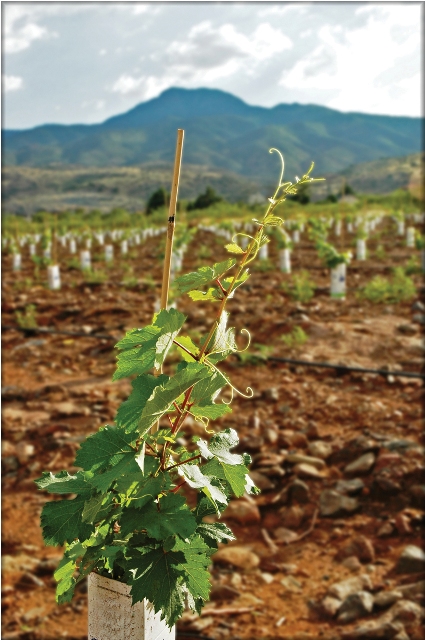June 9, 2011 —
Next stop on my Southwest Winery Tour was Arizona, the Grand Canyon State. With its mountains and deserts, Arizona’s wine industry faces interesting climate challenges. Most vineyards are located around Wilcox in the southeast corner of the state, with a few scattered around Flagstaff. With the high altitudes (Elevation: Wilcox 4168 ft & Flagstaff at 7000 ft) and the deserts, the nights are cool, but the days are very warm or hot. This kind of terrain and climate is suited well for Syrah, Malbec, Sangiovese and Tempranillo. However, what I found while there was that many wineries are tempted to emulate California by growing Cabernet, Merlot and Chardonnay. Although there has been some success with these, Arizona is in the middle of developing their own identity and could benefit from focusing on varietals best adaptable to the state.

Texas struggled with this early on as well, by trying hard to grow the Big 3. And while some parts of Texas can grow some high quality Cabernet, Merlot and Chardonnay, those grapes are not well suited to most of Texas. Growers end up with highly variable quality and volume year to year. Most often growers constantly struggle with producing enough grapes to actually make a living, while other years are at a total loss.
So, why do we insist on mimicking California and France by growing these three grapes in areas that are not suited for them? The wineries’ assumption is that consumers will not buy wines if they don’t know the name of the grapes. But there are some wineries that are taking on that challenge and crafting premium wine blends. Arizona Stronghold Vineyards has been a key player in elevating the Arizona wine industry over the past several years. With a commitment to use an “overwhelming majority of estate grown grapes” in every wine, they must work in a cooperative effort with the land and climate, choosing the best varietals for the area. From their website, “The core of the red plantings are Syrah, Grenache, Mourvedre, Tempranillo and Sangiovese with Viognier and Malvasia Bianca anchoring the white plantings.” They are venturing out from the norm and planting what will grow well and make the best quality wine.
Is it true that consumers won’t buy wine if they don’t know the name of the grape? I don’t think so. Another little story. A new winery opened in a town in west Texas with no other wineries around for a 100 miles. With an estimated population of about 300,000 the town is not a sophisticated wine market. With no other wineries, no education on grapes or styles, the number one selling wine is a Tempranillo, outselling their Chardonnay, Cabernet and Merlot, which have all won awards themselves. Customers have come to love this wine, stopping by to purchase it specifically. It’s actually even a bit more expensive than the others. The customers don’t know the grape and they don’t care. What they do know is that it’s good wine. Period.
So what happened here? If consumers really only want Cabernet, Merlot and Chardonnay, what is the difference? One comparative difference is winery visitors versus grocery shoppers. People taking an afternoon to visit a winery want to try something unique, something they haven’t had before. Once these visitors tasted Tempranillo, they loved it and now come in for it. Another thought is that wine making and wine consumption is growing and with that come new, younger, more adventurous consumers. They aren’t afraid of trying something new and frankly may actually be tired of the same ol’ same ol’.
Right now, as a small winery owner in Arizona or elsewhere, you’re thinking about harvest, your next blend and perhaps whether you want to plant a varietal that is unknown to the often uneducated public. Do it! Plant a grape the land will nourish and grow easily. Give yourself a chance to develop your own winery’s identity by creating wines unique to your area. And for sure, give your customers some credit! They will be excited to have discovered this “new” varietal or blend. But ultimately, it’s up to you to make a kick-ass wine, whether it’s a Chardonnay or Viognier or Malvasia Bianca. If it’s good, it’s good!
Previous blogs of my Southwest Winery Tour: Oklahoma and Colorado
Premier Wine Blends provides custom solutions for your winery.
Finely crafted wine blends, consulting and
local premium bulk wine sourcing (because you’re not a Napa winery!)
Comments
Write a comment: